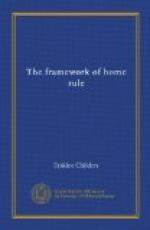Am I weakening the case for democracy itself in pressing this view? Surely not. One democracy is incapable of understanding the domestic needs and problems of another. Whenever, therefore, a democracy finds itself responsible for the adjudication of a claim for Home Rule from white men, it should limit itself to ascertaining whether the claim is genuine and sincere. If it is, the claim should be granted, and a Constitution constructed in friendly concert with the men who are to live under it. That way lies safety and honour, and, happily, the democracy is being educated to that truth. If this be a counsel of perfection; if the difficult and delicate task of settling the details of Irish Home Rule is to be hampered and complicated by the resuscitation of those time-honoured discussions over abstract principles which ought long ago to have been buried and forgotten, let every patriotic and enlightened man at any rate do his best to sweeten and mollify the controversy, to extirpate its grosser manifestations, and to substitute reason for passion.
The grant of responsible government to the Transvaal and Orange River Colony reacted with amazing rapidity on South African politics as a whole. It took the Canadian Provinces twenty-seven years (if we reckon from 1840), and the Australian States forty-five years (if we reckon from 1855), to reach a Federal Union. Hardly a minute was wasted in South Africa. Under very able guidance, the scheme was canvassed almost from the first, and in two years trusted leaders of both races, representing Natal, Cape Colony, and two newly emancipated Colonies—men, some of whom had been shooting at one another only five years before—were sitting at a table together hammering out the details of a South African Union. Here, indeed, was shown the “practical genius” which the Government of 1905 had piously invoked for their abortive Constitution. In the spirit of forbearance, of sympathy, of wise compromise, which governed the proceedings of this famous Conference, was to be found the measure of the longing of all parties to extinguish racialism and make South Africa truly a nation. The Imperial Act legalizing the arrangements ultimately arrived at by the agreement of the colonists was passed in 1909. The political system constructed cannot be called Federal. The framers rejected the Australian model, and went much beyond the Canadian model in centralizing authority and diminishing local autonomy; nor can there be any doubt that the strongest motive behind that policy was that of securing the harmony of the two white races.
All this was the result of trusting the Dutch in 1906. “We cannot expect you to trust us, and we shall not trust you,” said the despatch of 1905. We know what the consequences of that policy would have been. It is not a question of imagination or hypothesis. It is a question of the operation of certain unchanging laws in the conduct of all white men. Good or bad, our government would have been




